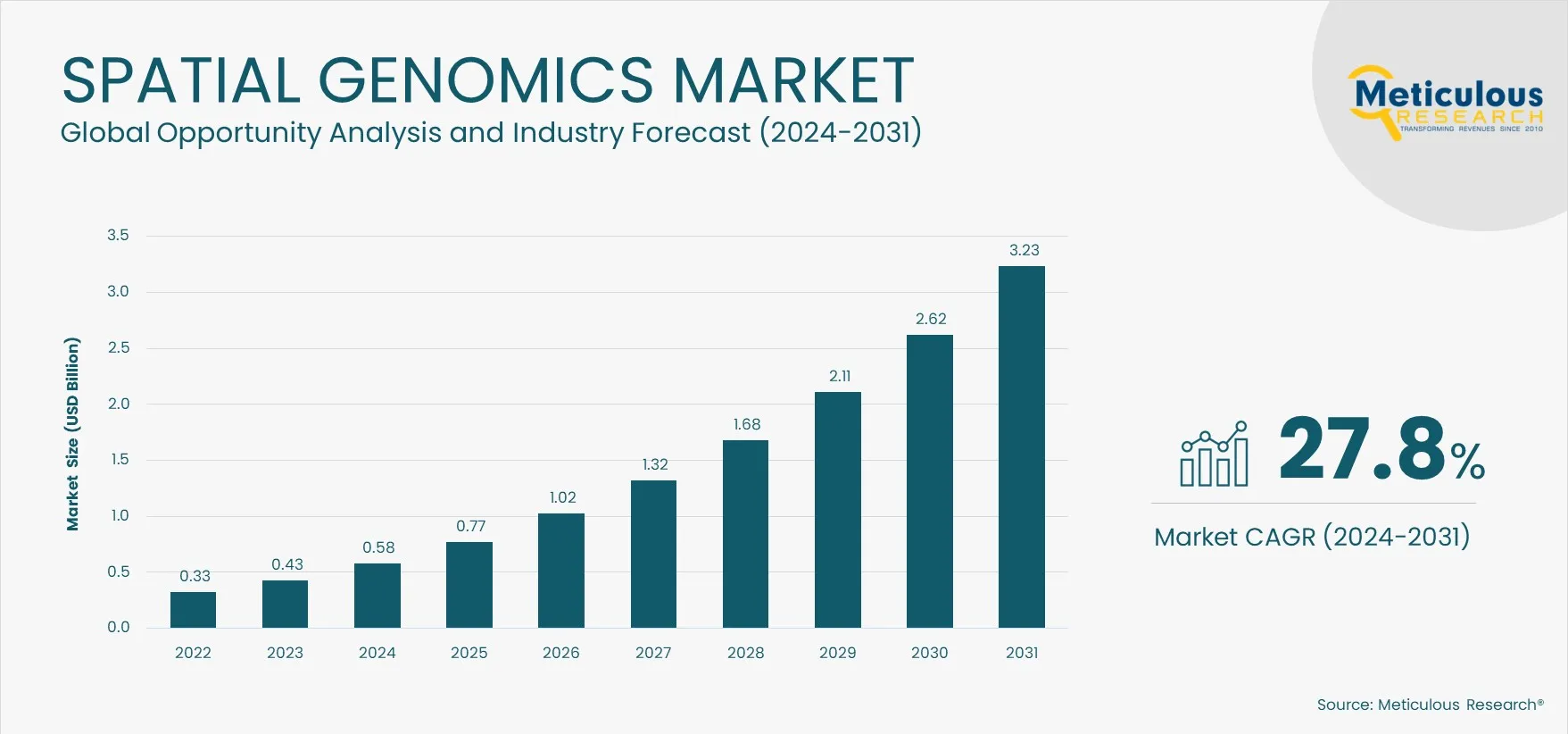The Spatial Genomics Market is projected to reach $3.23 Billion by 2031, at a CAGR of 27.8% during the forecast period. Spatial genomics & transcriptomics is the study of the expression and content of genome and transcriptome within a native spatial manner. Spatial genomics is the combination of in situ hybridization techniques and molecular biology techniques such as next-generation sequencing. Spatial genomics has applications in developmental biology, oncology, neurology, immunology, and others.
The growth of the spatial genomics market is driven by the increasing applications of spatial genomics in drug discovery & development, the growing use of spatial genomics in cancer research, advancements in Next-generation Sequencing (NGS), the increasing use of spatial genomics in biomarker detection, and the rising prevalence of cancer. However, the lack of standardized approaches in genomics and concerns over the security & privacy of genomic data restrain the growth of this market.
Furthermore, the rising adoption of personalized medicines & gene therapies and increasing investments in spatial genomics are expected to generate growth opportunities for the players operating in this market. However, complexities in data analysis and slow technology adoption are major challenges impacting market growth.
Here are the top 10 companies operating in Spatial Genomics Market
10X Genomics, Inc. (U.S.)
Founded in 2012 and headquartered in California, U.S., 10X Genomics, Inc. is engaged in bringing advances in biomedicine to transform the treatment of diseases. The company’s product portfolio mainly comprises integrated solutions, including consumables, instruments, and software to analyze biological systems. The company offers spatial genomics & transcriptomics products from the Visium and Xenium platforms.
The company provides products for COVID-19, infectious diseases, immunology, cancer, neuroscience, and drug discovery and has 1,750 patents issued or filed. The company has 304 publications in Spatial Gene Expression for Fresh Frozen and 30 publications in Spatial Gene Expression for FFPE
10X Genomics has a presence in some of the major geographies globally, including the U.S., Europe, the Middle East & Africa, and Asia-Pacific, with the presence of distributors in China, Taiwan, Brazil, Israel, Turkey, Spain, and others.
NanoString Technologies, Inc. (U.S.)
Founded in 2003 and headquartered in Washington, U.S., NanoString Technologies, Inc. develops, manufactures, and distributes life science tools for translational research and molecular diagnostic products. The company’s products are based on the novel digital molecular barcoding technology invented at the Institute for Systems Biology (ISB) in Seattle, U.S.
The products are used in clinical research and scientific discovery applications. The company operates through one reportable segment and offers spatial genomics & transcriptomics products through the same. The company currently markets and sells three platforms based on its proprietary technologies: its nCounter Analysis System, its GeoMx Digital Spatial Profiler, or GeoMx DSP or GeoMx, and CosMx Spatial Molecular Imager, or CosMx SMI or CosMx.
NanoString Technologies, Inc. has a geographical presence in the U.S., Canada, certain European countries, China, Japan, Singapore, South Korea, and India, among others. The company distributes its products via direct distribution in the U.S. and Europe and through third party distributors in the rest of the world.
Akoya Biosciences, Inc. (U.S.)
Founded in 2015 and headquartered in Massachusetts, U.S., Akoya Biosciences, Inc. is a spatial biology company that provides comprehensive single-cell imaging solutions for phenotyping the cell for spatial context. The company offers spatial biology products through the two key platforms, PhenoCycler and PhenoImager Fusion.
The company has a geographical presence in North America, Asia-Pacific, Europe, and the Middle East & Africa. The company’s subsidiaries include Akoya Biosciences UK Ltd. (Akoya UK). The company has a total of 772 publications featuring the company’s platform.
The company has partnerships with many life science and biopharma companies, including Dana Farber Cancer Institute (U.S.), Johns Hopkins University (U.S.), UCSF (U.S.), MD Anderson (U.S.), AstraZeneca plc (U.K.), Acrivon Therapeutics (U.S.), and Agilent Technologies, Inc. (U.S.).
Illumina, Inc. (U.S.)
Incorporated in 1998 and headquartered in California, U.S., Illumina, Inc. provides sequencing and array-based solutions for genomic and genetic analysis. The company operates through two reportable segments: Core Illumina and GRAIL. The Core Illumina segment offers a spatial genomics & transcriptomics solution.
Illumina provides its products to government laboratories, genomic research centers, academic institutions, hospitals, commercial molecular diagnostics laboratories, and pharmaceutical and consumer genomics companies.
The company has manufacturing sites and laboratories in the U.S., Singapore, and the U.K. Illumina distributes its products globally in North America, Europe, Latin America, Asia-Pacific, and the Middle East & Africa through its distributors. Some of its subsidiaries are Illumina GmbH (Germany), Illumina Australia Pty. Ltd. (Australia), Illumina UK, Ltd. (U.K.), Illumina Italy S.r.l. (Italy), Illumina Netherlands B.V. (Netherlands), and Illumina K.K. Japan (Japan)
Oxford Nanopore Technologies Plc. (U.K.)
Founded in 2005 and headquartered in England, U.K., Oxford Nanopore Technologies Plc. manufactures devices that sequence DNA/RNA directly. The company’s principal activities are to research, develop, manufacture, and commercialize a nanopore-based sequencing platform that allows real-time analysis of DNA or RNA.
The company operates its business in two reporting segments: Life Science Research Tools (LSRT) and Covid Testing. Both these segments provide spatial genomics & transcriptomics products. The Life Science Research Tools business segment offers NGS products to universities, commercial laboratories, and industrial or government research laboratories.
The company operates its businesses in more than 120 countries. Products are shipped globally from four international distribution hubs located in the U.K., Europe, the U.S., and China. Through distributors, commercial activities are supported in certain countries and regions, including China, Japan, Turkey, India, South Korea, UAE, Latin America, and parts of Africa.
Revvity, Inc. (U.S.)
Founded in 2023 and headquartered in Massachusetts, U.S., Revvity, Inc. is a multinational company that offers products, solutions, and services for the life sciences, diagnostics, and applied markets. In 2023, PerkinElmer, Inc. (U.S.) launched a scientific solutions company, Revvity, Inc. It operates through two reportable business segments: Discovery & Analytical Solutions and Diagnostics.
Discovery & Analytical Solutions segment operates in the life sciences and applied market. The company offers spatial genomics & transcriptomics products through the life sciences business segments.
The company’s manufacturing and R&D facilities are in several countries, including the U.S., China, Japan, and Germany. Furthermore, the company has a strong network of sales and marketing channels and service personnel in over 38 countries and sells its products and services in over 190 countries. Revvity sells products and services predominantly through its distributors.
S2 Genomics, Inc. (U.S.)
Founded in 2016 and headquartered in California, U.S., S2 Genomics, Inc. develops spatial sequencing technology solutions for processing solid tissues for single-cell applications. The company is developing integrated sample preparation systems for processing tissues into genomic samples for single-cell genomics and cell biology studies.
The company’s technology platforms integrate advanced fluidics, optics, and biochemistry to produce automated sample preparation solutions for single-cell sequencing and cell biology markets. This enables discovery and innovation in life science research, healthcare, and agriculture. The company has partnered with Parse Biosciences (U.S.), Dolomite Bio (U.K.), Applied Cells Inc. (U.S.), and Mission Bio (U.S.). The company partnered to provide automated solutions to the entire solid tissue to single cell/nuclei genomics analysis workflow.
The company has a network of distributors in China, Canada, Japan, Singapore, Austria, the U.K., France, Israel, and others. Some of the distributors include D-Mark Biosciences Inc. (U.S.), TrendBio Pty Ltd. (Australia), Novogene Co., Ltd. (China), Thunderbio Science (South Korea), and EuroClone (Italy), among others.
Cantata Bio (U.S.)
Founded in 2022 and headquartered in California, U.S., Cantata Bio is a multiomics tool company that offers NGS-based products and services. The company was formed with the merger of two companies, namely Dovetail Genomics (U.S.) and Arc Bio, LLC. (U.S.). The company offers products to researchers to gain information about metagenomic, epigenomic, and genomic information. The company operates in three business units: Microbial Profiling, Genetic Analysis Solutions, and Genome Assembly & Epigenetics.
Genetic Analysis Solutions products are provided by Dovetail Genomics (U.S.). The company offers spatial genomics products through Dovetail Genomics (U.S.). The company offers products for human disease research, epigenetic analysis, and plant & animal genome assembly. The company also offers services for genome assembly and epigenetics.
Vizgen Inc. (U.S.)
Founded in 2019 and headquartered in Massachusetts, U.S., Vizgen Inc. develops next-generation spatially resolved transcriptomic profiling tools to provide new insight into biological systems. The company offers products from three product categories: Software, Consumables, and Services.
The company’s products are based on the Multiplexed Error-Robust Fluorescence In-situ Hybridization (MERFISH) technology. The company provides products for the application areas, including oncology, immunology, neuroscience, development biology, infectious disease, and regenerative medicine.
Vizgen has a direct sales and support presence in the UK, BENELUX, Nordics, France, Germany, Austria and Singapore. Vizgen also works with many distributors across Europe, the Middle East, and Asia-Pacific to provide access to the MERSCOPE Platform.
Biospyder Technologies Inc. (U.S.)
Founded in 2011 and headquartered in California, U.S., Biospyder Technologies Inc. offers next-generation spatially resolved transcriptomic profiling tools for monitoring genes at once in high throughput. The company provides panels, assays for the dried blood spot, single-cell genomics, and formalin-fixed paraffin-embedded (FFPE) tissue.
The company’s products are based on TempO-Seq technology. The technology is based on the company’s proprietary Templated Oligo Detection Assay. TempO-Seq (Templated Oligo-Sequencing) is based on the hybridization and sequencing of highly specific detector oligos. The technology is patent-protected in the U.K., U.S., and Singapore.
The company’s product development is supported by the National Institutes of Health (U.S.), specifically the National Human Genome Research Institute (U.S.), the National Institute of Environmental Health Sciences (U.S.), and the National Center for Advancing Translational Science (U.S.).

























